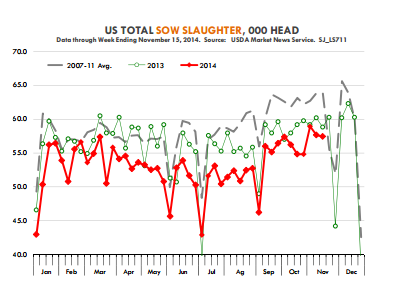



CME: US Hog Markets Down Due to Disruption of PED
US - The hog market is down 5.9 per cent after a disruptive autumn and winter caused by porcine epidemic diarrhoea (PED), write Steve Meyer and Len Steiner.The spread of PEDv across much of the US in the fall of 2013 and winter and spring of 2014 significantly impacted breeding operations.
While the disease was deadly only for baby pigs, it was quite disruptive for the entire operation as producers sought to clean out their barns. Sow slaughter declined significantly this summer, however, as PEDv cases dropped and producers were looking at some of the best margins in years.
Sow slaughter in the first ten months of the year was 2.311 million head, 146,100 head (-5.9 per cent) lower than a year ago. Sow slaughter has increased in recent weeks, a largely seasonal development.
The key in the hog market will be the rate of gilt retention, especially as producers go from playing defense against the PEDv virus to a more growth oriented strategy.
USDA does not provide any data on gilt retention but numbers from University of Missouri suggest that gilt slaughter continues to run ahead of last year’s levels.
If that is the case (and considering the increase in sow slaughter recently), hog breeding stock may not increase as much as some expect in the coming months despite the mountains of corn across the Midwest.
Heavy weights rather than a larger herd may continue to be the trend in the hog market for a bit longer.









